The members of the mob were all hooded and armed. One of them tied a rope around the neck of Quentin Rankin, 39- year-old attorney for the West Tennessee Land Company, and tossed the other end around a strong tree branch. Rankin was lifted into the air for a few seconds. Then he was lowered to the ground.
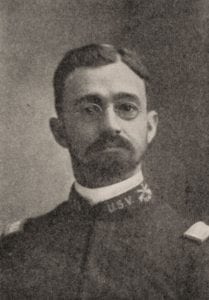
“Are you gonna compromise?” Rankin was asked. The lawyer adamantly refused.
Rankin was lifted into the air again, then lowered and asked a similar question. Again he said no. “Gentlemen, don’t do that. You’re killing me,” he gasped.
As if that plea were a signal, one of the hooded men fired a shotgun into Rankin’s chest. The noise echoed into the woods and swamps surrounding the lake. It shocked most of the men who were present, many of whom later testified that they had not intended to commit murder that night.
Everyone heard the sound of a man fleeing, then a splash as he dove into the shallow, tree- and stump-filled waters of Reelfoot Lake. Realizing their other prisoner had made a break for it, the members of the mob opened fired in the general direction of the sound. They had no intention of letting Robert Taylor live to see another day.
Reelfoot Lake was formed by the New Madrid Earthquakes of 1811 and 1812. As a result of those upheavals, water overflowed the banks of the Mississippi River and inundated much of present-day Lake and Obion counties. A lot of this water remained, forming a body of water that is about 23 square miles but with an average depth of only about 5 feet deep.
Settlers began moving into northwest Tennessee after the Chickasaw Indians were forced out in the early 1800s. Many of these small farmers found they could help feed themselves and supplement their incomes by fishing in the lake. By around 1900, an estimated 500 families in Obion and Lake counties were doing just that.
However, starting around 1870, a man named James Harris began buying up the land under and around the lake. In 1899, Harris announced that he owned the lake and said he intended to drain it and farm the land under it. A group of business owners and citizens of the Reelfoot Lake area filed a lawsuit aimed at blocking Harris from doing that.
This lawsuit eventually reached the Tennessee Supreme Court and forced Harris to abandon his plans to drain the lake. But after James Harris’ death in 1903, his son (whose first name was Judge) took over the property. In 1905, Judge Harris announced his intention to stop all people from using the lake without paying him a fee. He formed a business known as the West Tennessee Land Company to own, operate and make a profit from the lake and its shoreline.
The people who made their living and fed their families by fishing on Reelfoot Lake felt like they were running out of options. One of them, Tom Johnson of the Obion County community of Hornbeak, later summarized his point of view in this manner:
“[God] saw that we couldn’t make a livin’ farmin’, so he ordered an earthquake, an’ the earthquake left a big hole. Next he filled the hole with watah an’ put fish in it. Then he knew we could make a livin’ between farmin’ and fishin’. But along comes these rich men who don’t have to make no livin’, an’ they tell us all that we must not fish in the lake any mo’, cause they owns the lake an’ the fish God put theah foh us. It jus’ naturally ain’t right, strange; it ain’t no justice.”
At the time, there was a nationally publicized wave of violence in southern Kentucky between tobacco farmers and the American Tobacco Company. As part of that rebellion, many tobacco farmers began attacking tobacco company property and farmers who were siding with the company. These rebel farmers donned black hoods and attacked at night, on horseback, and became known as “night riders.” (There does not appear to have been a direct relationship between the Ku Klux Klan and the night riders.)
Inspired by the night riders in tobacco country, many of the fishermen and their friends — often as many as 100 at a time — began making night rider raids against the West Tennessee Land Company and its allies. The attacks went on for seven months and soon became an instrument of vengeance against people who may or may not have had anything to do with the West Tennessee Land Company.
Paul Vanderwood’s “Night Riders at Reelfoot Lake” is the definitive book on this subject. Researched in the 1950s, Vanderwood interviewed about 25 people from Obion and Lake counties who lived through that era, including seven people who had once been night riders. Here are some of the crimes committed by the night riders, according to Vanderwood’s book:
- They burned the privately owned fishing docks of J.C. Burdick (in Sanburg) to punish him for his business dealings with the West Tennessee Land Company.
- They whipped a physically hunchbacked Lake County official named George Wynne, allegedly for making derogatory comments about night riders.
- They whipped a woman named Emma Johnson because she was attempting to divorce her husband, Joe Walker (a night rider 30 years older than she).
- They crossed into Kentucky and murdered a black man named Dave Walker, along with his wife, daughter and baby — reportedly because Walker had insulted a white woman and pulled a gun on a white man.
It is a reflection of the times that the Walker family murders didn’t compel Tennessee state officials to react (however, the governor of Kentucky did, promising a pardon to anyone who shot and killed a night rider.) Tennessee indignation toward the night riders peaked two weeks later.
On Oct. 19, 1908, West Tennessee Land Company attorneys Rankin and Taylor were dragged from a hotel in the community known as Walnut Log. Rankin was hanged from a tree and shot; Taylor fled into the swamp amid a storm of bullets and was presumed dead by his captors.
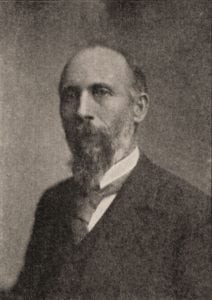
However, under a barrage of gunfire, Taylor slipped underwater and hid behind a partially sunken tree that had fallen into the lake. The 63-yearold Confederate veteran remained there in the darkness for nearly an hour until the night riders finally left. Taylor then swam, waded and staggered north and west through swamps and bayous.
On the morning of Oct. 21, Taylor reached a friendly farmer who fed him, gave him medical aid and alerted authorities. By that time, he had been missing for 30 hours and traveled more than 25 miles. The story of his survival was publicized in newspapers across the country. It eventually became Southern legend and was discussed at length in a short story called “In the Miro District,” written in the 1970s by Taylor’s grandson, Peter.
With the murder of Quentin Rankin, Tennessee Gov. Malcolm Patterson finally reacted, calling out the Tennessee National Guard to restore order in the Reelfoot Lake area. Working with law enforcement officials and hundreds of volunteers, they rounded up about 50 suspects.
There was concern that an Obion County jury would never have the courage to convict the accused murderers in the night rider case. However, by that time, many residents of Obion County were more disgusted by the terrorists’ methods of the night riders than they were afraid of them.
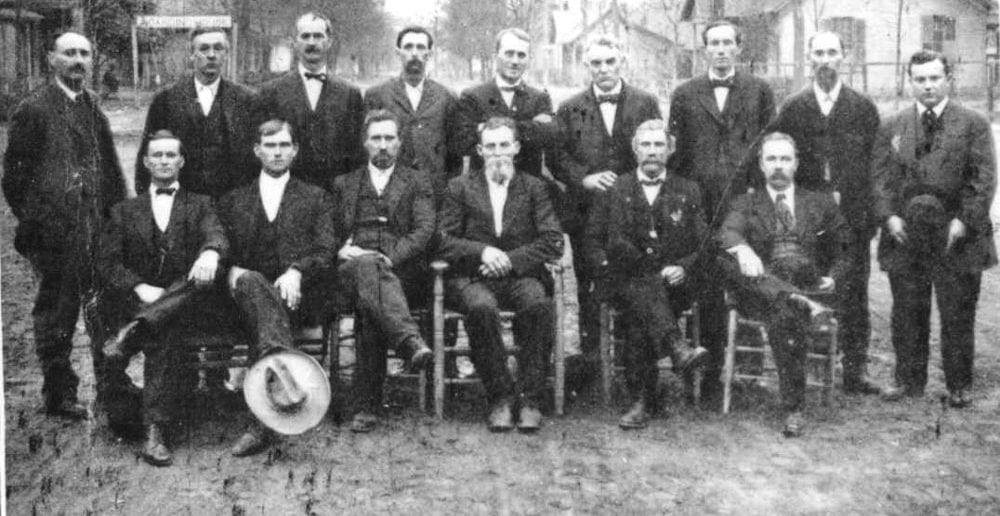
In January 1909, a jury found eight night riders guilty and sentenced six of the eight to death. The verdict and the sentence were, at the time, hailed as a triumph of law and order. “The conviction of these men,” said the Memphis Commercial Appeal, “marks the turning point of nightriderism toward its decline.”
However, the Tennessee Supreme Court later overturned these convictions because of the manner in which the judge had chosen the jury. The men were never tried again. There is, however, no evidence that night riders ever committed another crime in the Reelfoot Lake area. “They had experienced a close call with the gallows and had no stomach for further night riding,” one of the officers in the state militia later said.
In 1914, the state of Tennessee purchased Reelfoot Lake and much of its shoreline. A law was passed declaring the lake public domain, which means people can fish there, regardless of who owns the shoreline. Today the lake and much of its shoreline are public property. People fish, hunt and sightsee on and around the lake at places such as Reelfoot Lake Wildlife Refuge and Reelfoot Lake State Park.



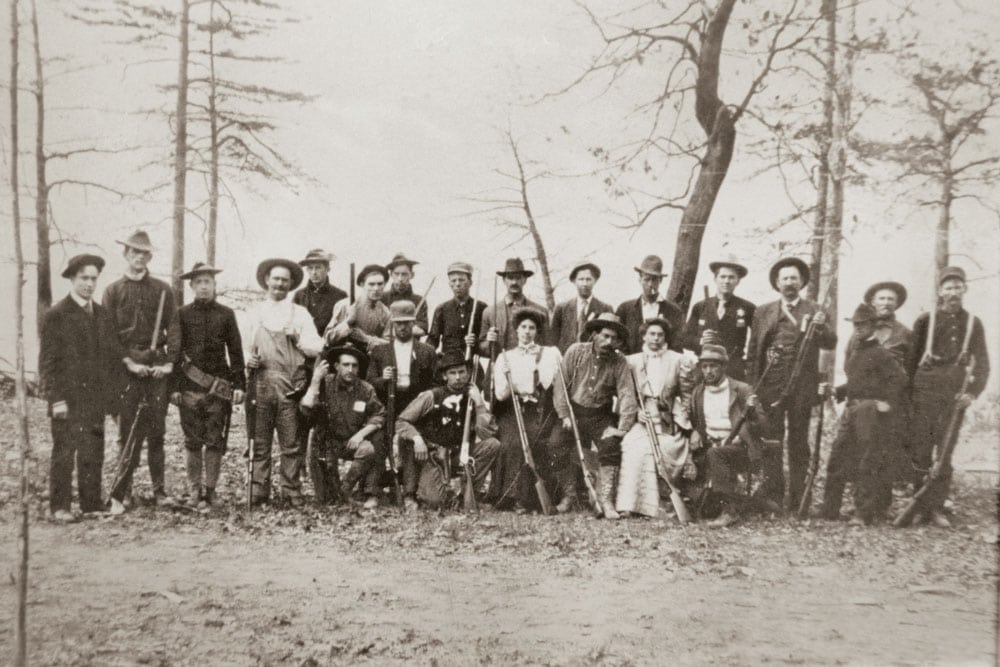
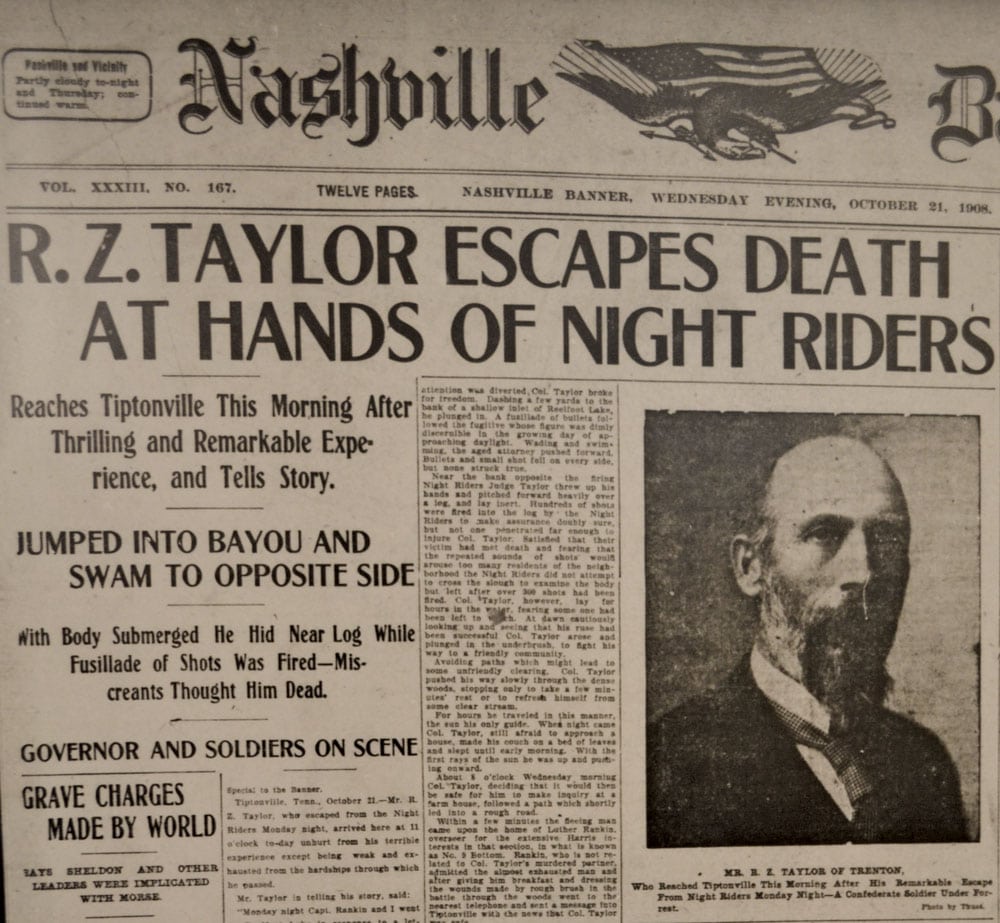
19 Comments
Such an important Tennessee history source.
Thank you so much from a displaced Tennessee born and Tennesseean to the bone,that appreciates reading my history.
Thank a—
WAS GLAD TO READ THE HISTORY OF RELFOOT LAKE.I WAS BORN AND RAISECD IN WEAKLY COUNTY TN MY DAD USE TO TAKE US THERE AND STAY OVER NIGHT CAMPING AND FISHING.AFTER I GREW UP AND GOT OUT OF THE ARMY I MOVED TO MICHIGAN. YEARS LATER I TOOK MY WIFE AND FAMILY THERE TO CAMP AND FISH AT BLUE BANKS.MANY GOOD TIMES SPENT THERE . BEAUTIFUL SCENERY AND CYPRESS TREES. I ONCE OWNED A LAMP I MADE FROM A CYPRESS KNEE.
My grandfather and his brother-in-law were night riders, they were ask by family to leave Obine Co. in
1910 they went to Missouri. Lost everything they had. My grandfather roamed up and down the river working cutting timber. Made money for a team and wagon. Started farming , had three children when they left . My father was born in Arkansas , we never knew we had family in Tennessee until I started my
Ancestry. My father had died my brother and I were shocked, we went there and found so much family history. Meet lots of grandmothers family and boy did they fill us in on what happened . Cousins said the never expected to see any of her family again. My grandfathers family to this day say we are not kin !
I am 78 years old what a trip in the past.
GREAT READ AND AN INTERESTING BIT OF WEST TENNESSEE HISTORY
Wish also you could find more information about Reelfoot Tennessee. It was a town that I think disappeared in one of the Mississippi River floods maybe in the 30″s. My great grandfather was a sheriff of Reelfoot and was killed in the line of duty. His name was George Washington Putman.
Hi, I’m conducting a research project on the nightriders for a national project. I would love to email with you and talk about your relation to the night-riders, and what first hand knowledge you have of them. Thank you
Hello. I am very interested in this history of Reelfoot Lake. My granddaddy’s family were all from Tennessee and his mother grew up in Tiptonville on Reelfoot Lake. I think the “Tom Johnson” quoted in the article could be a distant relative of mine. I am related to the Johnson’s and the Weeks (Weaks?) from that area of Tennessee. Actually, the Johnsons started just south of Nashville in a region that used to be known as Cane Ridge. My grandparents have a book that has all the families that used to live there. It was like a whole village of Johnsons. If anyone on here knows anything about the Johnsons or Weeks please feel free to reply to this comment. I am always interested to learn more about where I came from.
I am a native of Robertson County, TN transplanted in MS. Two of my grandfather’s uncles rode in TN/KY with the night riders. Yes, they were also Hatfield’s.
the only thing i can think of as someone from the area, most of the people i’ve around here met with a name pronounced like “weeks” actually spell it like “weekes” or sometimes even “weakes.” i know it’s not much, but it might come in handy if ever you’re trying to look people up on an ancestory website or something 🙂 best of luck!
My grandfather grew up in Hornbeak, near the Lake, and he made his meager living from fishing, hunting, and trapping on the Lake. He was right in the middle of the fight, but claimed he was never a member of the Night Riders. But some of the stories he told were sort of suspicious, as they told more than he should have known if he was not a member.
Wow… really insightful comment, Nancy. I guess I’ve never thought to question of doubt any of the family stories I’ve been told about my relatives, but maybe we should all think about them.
My great great grand father and his family lived in Jackson, TN. In the social column of the paper was a note that he was going to vacation at Reelfoot Lake. This would have been about 1880.
This was a very interesting read for me. I grew up in Carroll County but I’ve never heard anything about the night riders in the area. My husband is a big history buff so I’ll definitely have to share this story with him! It really is thought provoking as it makes you wonder what all has happened in the area that we live our day to day lives. Thanks for the information!
My grandfather was a night rider. Walter Archie. They were sworn to silence. Fred Pinion one of the leaders of the night riders came to my Grandfathers house all the time, they were neighbors, so was ED Marshall. My grandmother said you could here the riders coming for miles. They stopped at my Grandfathers house several times and talked. My grandfather didnt talked about it, One of my oldest uncles new.
The leader Fred Pinion of the night riders is my great grandfather. Js
My granddad’s sister was wife to Garrett Johnson. They came one night to force him to ride with them as they often did to men of the area. He knew they were coming and I have wondered if Garrett warned him but he hid out in the orchard “in a peach tree”.
My grandmother had lived in the area all her life and knew the neighbors and locals.
She stood facing the Riders that night, looked them over and knowing their horses as we would know a neighbors car. She spoke to several, calling by name, and asked about their wives and children as neighbors do. They left soon after without my granddad. I’ve always wondered if Garrett didn’t warn him to be absent that night.
He told me several stories of that time. I have wished many times I had been old enough to realize I needed to question him for details and keep a record.
My uncle was an infant and I’ll with polio. I don’t think he was expected to live and neighbors were there to help in the country way staying with the family, a southern tradition of “sitting up with the dying”. Women were gathered in the room with my grandmother and uncle, sitting and chatting. I’m sure the yard was probably full of men squatted down by a fire for either heat or to keep the mosquitos away depending on the season.
Three hooded men walked into the house where the women were and sat down. They sat a while silently and then got up to go. One stopped by my grandmother, Bernetta, called Net, and leaned down and whispered to her, “Hope the boy gets better, Net.”
Reading these comments bring back my granddads stories to me. I am 82 now and wish he had told me many more though I do know several from what he did say and I’ve learned since some others
My grandmother was from Reelfoot lake area her name was Lela Archie and she had several brothers. I bet we could be distantly related. She married a Haynes but he drowned then she married my grandfather Jess Cleaves and lived in Shelby Co near Memphis till she died from diabetes in her early fifties about 1959. My father told me stories about his uncles from Reelfoot Lake and how big and tough they were. He had heard stories about the night riders.
Some of My Fore Fathers on both sides of my family were Night Riders back in the early days of Reelfoot Lake an made their Livings from Hunting an Fishing it’s waters till this day an my Grand Father Bob Hamilton was the First State an Federal Game Warden on the Lake. an my Father an Mother JamieHamilton an Bonnie( Miller ) Hamilton had an Operated a Resort on the lake on its eastern Shores for over 60 years from 1942 till they sold Out to the State in the early 1990’s when they retired van my Grand father William ( Bill ) Miller an My Uncle Harry Miller operated Miller Boat dock for several years on lakes Eastern Shore line until thier Deaths